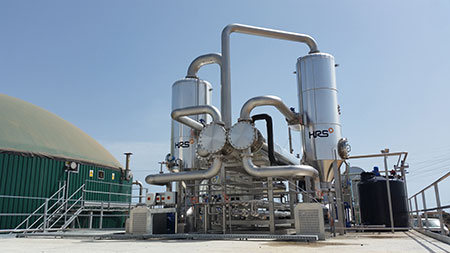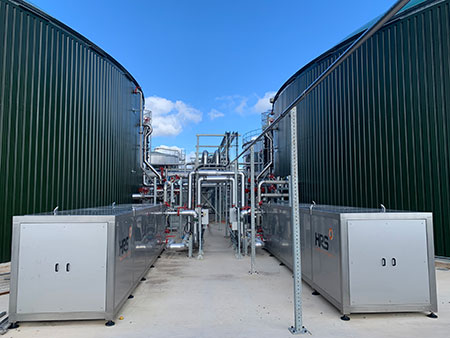
Conventional wastewater treatment in many regions consists of three distinct phases: primary, secondary and tertiary. The primary treatment involves the mechanical removal of solids by sedimentation or flotation and is followed by a secondary treatment that removes organic matter through microbial decomposition. A further final, or tertiary, treatment may also be required depending on the final destination of the wastewater—such as reentering the mains water supply.
The choice of secondary treatment depends on a number of factors, including the wastewater’s chemical and biological oxygen demand (COD/BOD), operational and maintenance costs, sludge production, desired effluent quality and microbial concentration. The choice is generally between aerobic or anaerobic treatment, although a combination of both methods can also be used.
In recent years, there has been a steady increase in the use of anaerobic digestion (AD) treatment techniques for the treatment of wastewater (and other effluent streams), but before examining what is driving this, it is important to understand the differences between aerobic and anaerobic treatment, as well as the pros and cons of each.
.jpg)
IMAGE 1: The capital investment (and space) required for aerobic treatment is usually greater than that needed for anaerobic facilities. (Images courtesy of HRS Heat Exchangers)
Aerobic vs. Anaerobic Treatment
Anaerobic and aerobic systems are both forms of biological treatment that use microorganisms to break down and remove organic materials from wastewater. The key difference between aerobic and anaerobic treatment is the presence of oxygen. Aerobic treatment is typically applied to efficiently treat low strength wastewater (with relatively low COD/BOD values) when the treatment requires the presence of oxygen. In contrast, anaerobic treatment is typically applied to treat wastewater with higher organic loading.
In aerobic treatment, oxygen (air) is used to circulate the material, providing the right conditions for aerobic bacteria to reproduce. These bacteria assimilate and then break down organic matter and other pollutants like nitrogen and phosphorus into carbon dioxide, water and biomass (sludge). As the name suggests, AD utilizes bacteria that do not need oxygen. They break down organic material in the wastewater into methane, carbon dioxide and biomass (digestate).
Some of the factors in favor of aerobic treatment include the fact that it has fewer odors (as hydrogen sulfide and methane are not produced), and nutrient removal from the wastewater to the sludge can be more efficient—meaning treated water can often be discharged directly into the environment. However, oxygenation of the wastewater can require large amounts of energy (or a large surface area for the treatment lagoon) and untreated biosolids can settle out from the process, requiring further treatment or disposal. The capital investment (and space) required for aerobic treatment is usually greater than that needed for anaerobic facilities.

IMAGE 2: The use of AD is rapidly increasing in the wastewater sector.
While there are pros and cons to both approaches, AD has several advantages, including:
- It is better at dealing with slurries with higher solids content.
- It produces biomethane gas, which can be captured and used as a renewable energy source (including providing the energy to run the AD plant itself).
- It produces less sludge (digestate) for a given volume of wastewater.
- The stable digestate produced by AD is easily converted into a valuable biofertilizer.
- AD plants generally have a smaller footprint than aerobic treatment.
While the final choice of aerobic or anaerobic wastewater treatment will depend on the situation of each treatment facility, the advantages outlined above, together with greater utilization and uptake of AD technologies including enclosed digesters and upflow anaerobic sludge blanket (UASB) systems, means the use of AD is rapidly increasing in the wastewater sector, either as the main secondary treatment or to further process the biosolids produced by aerobic processes.
Improving the Efficiency of Anaerobic Digestion
One of the major benefits of anaerobic treatment is its improved energy efficiency and the lower volume of residual solids produced as digestate. However, when designing or upgrading an AD plant, there are numerous ways to maximize operational efficiency, improving both economic returns and environmental performance.

IMAGE 3: This digestate concentration system reduces the costs of storage, transport and application of digestate
External digester heating offers several advantages over heating systems that are located in the digester. External heating can be checked, cleaned or serviced at any time without the need to empty (or enter) the digester. Other benefits include the fact that external systems can be designed so one heat exchanger array heats more than one digester, and the improved thermal performance reduces heating requirements and improves the overall energy efficiency of the AD plant. Operating life is often considerably greater compared to internal heating units, and routine maintenance is more straightforward.
Cooling and recovering the heat from exhaust gases can increase the efficiency of combined heat and power plants used to generate electricity from biogas. After digestion and biogas production, the digestate is often separated mechanically into solid and liquid phases. This increases the value and versatility of the digestate, but it can be costly in terms of energy use. Choosing an efficient process to concentrate digestate will not only save money, it will improve the carbon footprint of the AD plant and can actually boost the nutrient content of the digestate. Pasteurizing the digestate (or the feedstock) can both ensure crop and soil health and also increase the commercial value of digestate as a biofertilizer.

